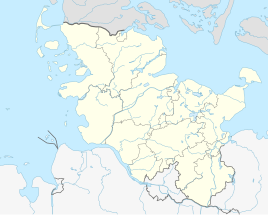Duburg barracks
| Duburg barracks | |||
|---|---|---|---|

Barracks building (1989) |
|||
| country | Germany | ||
| today | canceled, employment office Flensburg | ||
| local community | Flensburg | ||
| Coordinates : | 54 ° 48 ' N , 9 ° 25' E | ||
| Opened | 1877 | ||
| owner | City of Flensburg | ||
| Formerly stationed units | |||
|
Fusilier Regiment No. 86 6th Infantry Regiment Infantry Regiment 26th |
|
||
|
Location of the Duburg barracks in Schleswig-Holstein |
|||
The Duburg barracks was a military facility in Flensburg from 1877 to 1945. The complex was demolished after civil use at the end of the 1980s. Its name referred to the former Flensburg castle of the same name .
history
When Northern Schleswig became part of the German Empire in 1864, the Prussian military had to be expanded to the north. In 1869 the site not far from the former Duburg was acquired by the city of Flensburg and a barracks building was built according to plans by the garrison building inspector Bolte in 1876/77. After completion, the barracks were occupied by the Fusilier Regiment "Queen" (Schleswig-Holsteinisches) No. 86 . The unit had been set up in Zeitz and had already participated in the Franco-German War . The regiment was divided between the barracks at Sønderborg Castle (later also in the Sønderborg barracks ), Duburg and the Junkerhohlweg barracks . From 1890 Empress Auguste Victoria was head of the regiment and thus the unit received its nickname Queen . The north and south wings were extended again in 1914. Incidentally, in the 19th century or at the beginning of the 20th century the service building of the divisional command was built at the Hafenspitze , which apparently had a military connection with the Duburg barracks. (The Fusilier Regiment No. 86 belonged to the 18th Division in 1914 ).
After the First World War , the tradition of the 86s and the accommodations from the III. Battalion of the 6th Infantry Regiment of the Reichswehr. In the meantime, it was used by French and British occupation forces in 1920. To commemorate the fallen of Regiment 86, a memorial was erected in the St. Mary's Church in 1920 (removed due to church pressure in 1967) and in 1926 the monument on the guard on Burgplatz . The Auf der Wacht monument was relocated to the courtyard of the barracks in 1974 as part of a redesign of the Burgplatz. During the 1920s, PSV Flensburg used the barracks yard as a sports field.
After the Reichswehr was renamed the Wehrmacht , from 1936 the barracks was occupied by the 26th Infantry Regiment , which took part in the Poland, France and Russia campaigns in World War II and was crushed as the 26th Fusilier Regiment in the Battle of Courland in 1942. The tradition was later taken over by the 511 Jäger Battalion of the Bundeswehr in the Briesen barracks . After its dissolution in 1997, the Flensburger Jäger association took over. During the war, the barracks were used as a military prison and occupied by Infantry Replacement Battalion 209 and Artillery Replacement Division 58. Another 1930s-style building was built for this purpose, which was later used as a warehouse by the site administration.
At the beginning of March 1945 a reserve hospital with an attached pharmacy was set up in the barracks , in which only members of the General SS were taken care of. Many of the patients were released from the hospital before the surrender. The seriously wounded stayed behind. At the end of the war, the SS reserve hospital was placed under the guard of British and German guards. The Allies paid attention to which SS men could be released and which could not.
From the end of the Second World War , refugees were also housed in the barracks. In July 1946 the hospital was finally closed. Refugees also moved into the vacant premises.
After the establishment of the Federal Republic of Germany , the THW used part of it from 1952 to 1990. Apartments and a dance school were set up in other buildings. The western part of the barracks had already given way after the war.
In 1988 it was decided to demolish the barracks and use the space for a new employment office , which until 1994 was housed in an office architecture from the 1950s on Bahnhofsstraße / Munketoft. The memorial on the watch was stored, but then disappeared without a trace. Memorial boulders of the units from the Duburg barracks ultimately found their place in the military cemetery on the Peace Hill . Active barracks in Flensburg today only exist at the Flensburg-Mürwik base .
Individual evidence
- ↑ http://www.shz.de/lokales/flensburger-tageblatt/streit-um-den-krieger-in-der-kirche-id10750896.html
- ↑ http://dieter-finzen.blogspot.de/2011/06/das-verschwundene-denkmal-missing.html
- ↑ Flensburg Journal : February 2016, number 161, page 31 f.
- ↑ Flensburg Journal : February 2016, number 161, page 31 f.
- ↑ http://www.stadtarchiv-flensburg.findbuch.net/php/main.php?ar_id=3663
- ^ Andreas Oeding, Broder Schwensen, Michael Sturm: Flexikon. 725 aha experiences from Flensburg! . Flensburg 2009, article: Duburg barracks




